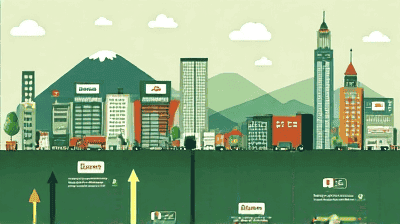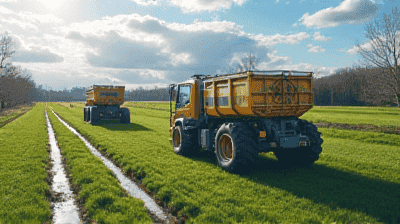
As urban populations continue to grow, cities face unprecedented challenges related to waste management. Traditional waste disposal methods are no longer sustainable, leading to overcrowded landfills, environmental degradation, and public health concerns. In response, a growing number of municipalities are embracing the Zero Waste movement, a philosophy aimed at minimizing waste to achieve a landfill diversion rate of 90% or more.
Zero Waste is not merely an environmental policy; it is a holistic approach to resource management that seeks to redesign current systems to eliminate waste entirely. This philosophy emphasizes the importance of reducing consumption, reusing materials, and recycling to create a circular economy where resources are continually repurposed rather than discarded. At the core of the Zero Waste movement is the principle of sustainability, aiming to protect natural resources and promote ecological balance.

The need for effective landfill diversion strategies is evident in various realms:
San Francisco stands as a global leader in Zero Waste efforts. Since the introduction of its Zero Waste Plan in 2002, the city has achieved a landfill diversion rate of approximately 80%, aiming for 100% by 2030. Key initiatives contributing to this success include:
Mandatory Recycling and Composting: In 2009, San Francisco became the first city in the United States to require mandatory separation of recyclables and compostables from landfill waste. Residents and businesses must sort their waste into three streams, significantly increasing recycling rates.
Outreach and Education: The city invests in extensive public education campaigns, promoting awareness about proper waste sorting and the benefits of reducing waste. This has empowered residents to actively participate in waste management initiatives.
Partnerships with Local Businesses: San Francisco works closely with local businesses, helping them reduce waste through waste audits, providing resources for sustainable practices, and encouraging innovative packaging solutions.
Kamikatsu is a small town that has garnered international attention for its ambitious Zero Waste goals. Since implementing its Zero Waste Declaration in 2003, Kamikatsu has established a diversion rate of around 80%. Its approach includes:
Separation of Waste into 45 Categories: Residents are required to categorize their waste into 45 distinct types, from paper and glass to specific categories of plastic. This meticulous separation has vastly improved recycling rates.
Community Participation: The local government actively engages citizens in the waste management process, ensuring that residents understand their responsibilities and the impact of their actions. Community workshops and educational programs foster a culture of sustainability.
Innovative Recycling Programs: Kamikatsu creates opportunities for reuse and recycling by hosting events where residents can bring unwanted items, encouraging the community to repurpose rather than dispose of items.
Ljubljana has taken significant strides toward sustainability and became the first European capital to adopt a zero waste goal. The city has achieved a landfill diversion rate of over 68% through various initiatives:
Pay-As-You-Throw System: This pricing system incentivizes residents to reduce waste. By charging fees based on the amount of trash generated, residents are encouraged to minimize waste and increase recycling.
Public Composting Programs: Ljubljana promotes composting through dedicated facilities and educational initiatives that encourage residents to compost organic waste, which significantly reduces landfill contributions.
Comprehensive Public Engagement: The city engages citizens through campaigns that highlight the importance of waste separation and offer guidance on sustainable practices.
This municipality in Tuscany has made remarkable progress in its journey toward Zero Waste, focusing on community involvement and innovative waste management solutions. Capannori has achieved a diversion rate of approximately 50% and is continuously working toward higher goals through:
Door-to-Door Collection Services: Capannori has implemented door-to-door waste collection systems that facilitate the separation of recyclables and organic waste, making it easier for residents to participate.
Promotion of Local Markets: The municipality encourages citizens to shop at local markets and use package-free products to reduce reliance on single-use plastics.
Participatory Decision-Making: Community engagement is central to Capannori's efforts, ensuring that citizens are involved in decision-making processes related to waste management.

While pursuing Zero Waste, municipalities often encounter significant challenges, including:
Public Resistance: Changes in waste management practices can meet resistance from residents who are accustomed to traditional disposal methods or skeptical of new regulations.
Infrastructure Limitations: Many cities lack the necessary infrastructure to support comprehensive recycling and composting initiatives, particularly in lower-income areas.
Contamination in Recycling Streams: Improper sorting leads to contamination, where recyclable materials become unusable, causing frustration and inefficiencies in the recycling process.
To overcome these challenges, cities are adopting several effective strategies:
Education and Engagement Programs: Offering workshops and educational resources helps inform residents about the importance of waste management and proper sorting practices.
Incentive-Based Programs: Implementing reward systems for residents who actively participate in recycling and composting encourages community involvement and fosters a cooperative spirit.
Collaborating with NGOs and Local Organizations: Partnering with non-profit organizations can boost community engagement and resources for effective waste management initiatives.
Technology is playing an increasingly significant role in enhancing municipal waste management systems. Some notable advancements include:
Smart Bins: Internet of Things (IoT) technology integrated into waste bins allows municipalities to monitor waste levels in real-time, optimizing collection schedules and reducing operational costs.
Mobile Apps for Recycling: Applications that educate users on proper recycling practices and information about local recycling facilities empower citizens to make informed decisions about waste disposal.
Data Analytics: Utilizing analytics tools helps municipalities track waste generation patterns, measure the success of existing programs, and inform policy adjustments.

Transforming a city into a Zero Waste community requires systematic planning and execution. Here are some best practices that city planners and leaders can adopt:
Establish Clear Goals: Develop specific, measurable objectives for waste diversion that aim toward zero waste in a reasonable timeframe.
Conduct Comprehensive Waste Audits: Assess current waste management practices to understand the types and quantities of waste being produced, identifying opportunities for improvement.
Implement Effective Policies: Introduce regulations mandating recycling, separating organic waste, and promoting reusable materials to lay the groundwork for a Zero Waste framework.
Foster Community Engagement: Actively involve residents in the decision-making process and encourage participation through educational initiatives, workshops, and public forums.
Monitor and Evaluate Progress: Continually review waste diversion rates and the successes or shortcomings of programs, making adjustments as necessary to improve effectiveness.
Innovate and Adapt: Stay informed about the latest innovations and best practices in waste management, and be open to adapting strategies as technologies and community needs evolve.
The Zero Waste movement is gaining momentum as cities around the globe recognize the critical need for sustainable waste management solutions. With examples from San Francisco, Kamikatsu, Ljubljana, and Capannori, it is evident that achieving a landfill diversion rate of 90% or more is not merely a lofty goal—it's an attainable reality. Through targeted programs, strong community engagement, and the integration of technology, these municipalities demonstrate that creating sustainable urban environments is possible.
As we collectively face climate challenges, more cities must embrace the Zero Waste philosophy and work toward minimizing waste and conserving resources. By fostering a culture of sustainability and collaboration, we can build healthier, cleaner, and more resilient communities for future generations.